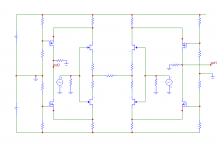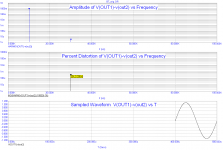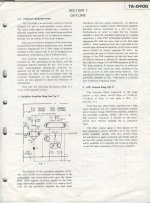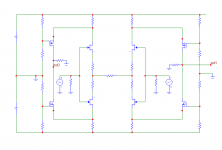At least the the TA-D900 is from 1981 (not from the 70´)...
It's a SONY !
That gain module is from their top of the line crossovers TA-D88 and TA-D900.
...
(I have the service manual here).
IMO it is high time for the CIRCUIT again, some might have forgotten and some might have never known
This circuit looks to me blameless. Possibly as good as it can get for a SS based line stage.
This circuit looks to me blameless. Possibly as good as it can get for a SS based line stage.
After several years, I have some new sims of this circuit, and it proves to be perfect.
Attachments
At least the the TA-D900 is from 1981 (not from the 70´) (I have the service manual here).
gk7,
According to the vintageknob TA-D900 is just repackaged TA-D88.
Can you check your service manual and tell me if the gain blocks in D900 look the same as this one?
http://www.diyaudio.com/forums/anal...torch-preamplifier-part-ii-2.html#post2977922
Thanks,
John,
You have a rival here! Someone actually built one of Pavel's ideas!
http://www.diyaudio.com/forums/soli...s-opamp-pavel-macuras-designed-amplifier.html
You have a rival here! Someone actually built one of Pavel's ideas!
http://www.diyaudio.com/forums/soli...s-opamp-pavel-macuras-designed-amplifier.html
Thank you, gk7. So we're back in 1978.Yes, they seem to be the same.
Servus,
But there is a picture of some kid pretending to be John.John you kicked butt on page 48 of the new Absolute sound for best preamps ever.(May/June)
Well, the 'chatter' has decreased, so maybe we can get something done.
What PMA has brought up and emulated (far better than I ever could) is the basic topology that is used by the Blowtorch preamplifier, which in turn, was a adaption of Charles Hansen's Ayre topologies, and inspired by the 'less is best' tube line stage developed by Art Ferris.
Now, many here will wonder why I might give so much credit to others for something that I am known for, namely balanced comp-differential fet designs. Well, my last design effort of major proportions stopped after Vendetta Research closed shop in 1992.
And at that time, I worked part time for Audible Illusions as a consultant, so I got to work with tube products for a period of time. Also, did some extra measurement of the open loop line stage that Art Ferris developed, using a parallel version of a single tube.
When I made the extended distortion measurement, more than 20 years ago, I used a wave analyzer on the distortion residue of an HP339 HD Analyzer, while measuring the line stage at some 'reasonable' output. I found very little, but 2'nd harmonic, maybe a little 3'rd, but nothing else within my measurement limit, at the time, which was perhaps -120dB down. I was impressed! NO single solid state device, running open loop, could match that. It seemed that that tube topology could not be copied with any real success in a solid state product. Perhaps, it is best to try a more sophisticated topology, WITH ESSENTIALLY THE SAME THRU-PATH, in order to get similar subjective results.
The first option, of course is the differential pair. The second option is the complementary differential fet quad, with AC coupling with 4 output caps, 2 summing for + out and 2 summing for - out.
The third option was to use the folded complementary differential cascode, much like Charles Hansen uses with his designs, to remove the output caps and the resistor loading distortion generation from having to use load resistors with a relatively low voltage power supply voltage for practical reasons.
This we tried, and this we succeeded in.
Of course, there were a hundred other problems and design decisions that had to be made, but in principle, we had a direct coupled in-out, open loop, differential or single ended in or out, so a selection of balanced and unbalanced configurations could be easily used. Our thru-path was at minimum, one comp cascode to an output, worst case was a differential fet pair and cascode to an output. About as minimum as I can get, and still get reasonably low distortion, open loop.
Superficially, there appears to be little difference between the JC-80 of 30 years ago, and the Blowtorch, but there are many significant changes in the 15-20 years that occurred between the original inception of these 'all out' designs. They are just more subtle to most people.
A good example of this is the 'cloning' of the JC-80 that has 2 threads here at this time.
It is a bit like trying to make a kit car into a Porsche. It can be done, but not consistently. Enough for now.
What PMA has brought up and emulated (far better than I ever could) is the basic topology that is used by the Blowtorch preamplifier, which in turn, was a adaption of Charles Hansen's Ayre topologies, and inspired by the 'less is best' tube line stage developed by Art Ferris.
Now, many here will wonder why I might give so much credit to others for something that I am known for, namely balanced comp-differential fet designs. Well, my last design effort of major proportions stopped after Vendetta Research closed shop in 1992.
And at that time, I worked part time for Audible Illusions as a consultant, so I got to work with tube products for a period of time. Also, did some extra measurement of the open loop line stage that Art Ferris developed, using a parallel version of a single tube.
When I made the extended distortion measurement, more than 20 years ago, I used a wave analyzer on the distortion residue of an HP339 HD Analyzer, while measuring the line stage at some 'reasonable' output. I found very little, but 2'nd harmonic, maybe a little 3'rd, but nothing else within my measurement limit, at the time, which was perhaps -120dB down. I was impressed! NO single solid state device, running open loop, could match that. It seemed that that tube topology could not be copied with any real success in a solid state product. Perhaps, it is best to try a more sophisticated topology, WITH ESSENTIALLY THE SAME THRU-PATH, in order to get similar subjective results.
The first option, of course is the differential pair. The second option is the complementary differential fet quad, with AC coupling with 4 output caps, 2 summing for + out and 2 summing for - out.
The third option was to use the folded complementary differential cascode, much like Charles Hansen uses with his designs, to remove the output caps and the resistor loading distortion generation from having to use load resistors with a relatively low voltage power supply voltage for practical reasons.
This we tried, and this we succeeded in.
Of course, there were a hundred other problems and design decisions that had to be made, but in principle, we had a direct coupled in-out, open loop, differential or single ended in or out, so a selection of balanced and unbalanced configurations could be easily used. Our thru-path was at minimum, one comp cascode to an output, worst case was a differential fet pair and cascode to an output. About as minimum as I can get, and still get reasonably low distortion, open loop.
Superficially, there appears to be little difference between the JC-80 of 30 years ago, and the Blowtorch, but there are many significant changes in the 15-20 years that occurred between the original inception of these 'all out' designs. They are just more subtle to most people.
A good example of this is the 'cloning' of the JC-80 that has 2 threads here at this time.
It is a bit like trying to make a kit car into a Porsche. It can be done, but not consistently. Enough for now.
Last edited:
A Blowtorch schematic outline, courtesy PMA.
Wow, so indeed, for quite some time, this guy correctly guessed the Blowtorch core schematic:
Uskok preamplifier
The author seem to be a member on this forum http://www.diyaudio.com/forums/members/moamps.html so it would be interesting to hear some comments about...
Talk about a clone, this preamp takes the cake! Too many similarities, and a few mistakes. I NEVER completely discussed the CTC Blowtorch schematic and the way that I do things, so without taking one apart, one could not possibly get every detail the same, but that's OK. This Russian preamp looks to be pretty good, better than most.
Why I am attacked for claiming ownership of certain ideas that I have worked with for decades, usually before anyone else seems to have done so, is beyond me.
The designer's final attack on me, was a bit 'below the belt'. As has been stated here, most of my circuit topology ideas have arisen between 10 and 45 years ago, so schematics get lost, get burned in a firestorm, or are deliberately kept away from competition, over the decades. The last time I openly discussed something 'important' to me with a competitor, I found that they had taken my design, almost part for part, much like this Russian preamp has done. They just took it from my patent, and they laughed at me when I protested. And so it goes.
Why I am attacked for claiming ownership of certain ideas that I have worked with for decades, usually before anyone else seems to have done so, is beyond me.
The designer's final attack on me, was a bit 'below the belt'. As has been stated here, most of my circuit topology ideas have arisen between 10 and 45 years ago, so schematics get lost, get burned in a firestorm, or are deliberately kept away from competition, over the decades. The last time I openly discussed something 'important' to me with a competitor, I found that they had taken my design, almost part for part, much like this Russian preamp has done. They just took it from my patent, and they laughed at me when I protested. And so it goes.
- Status
- Not open for further replies.
- Home
- Member Areas
- The Lounge
- John Curl's Blowtorch preamplifier part II




